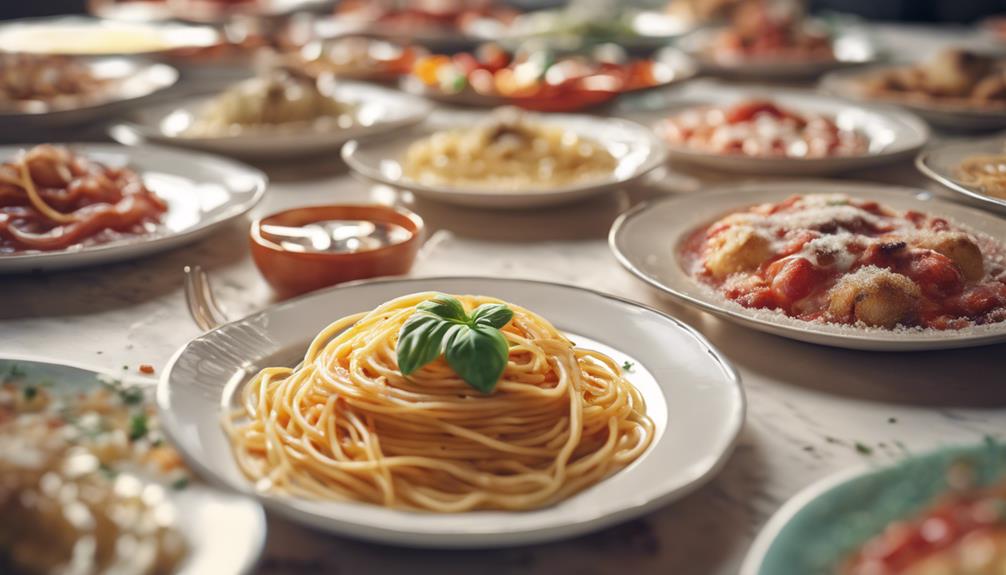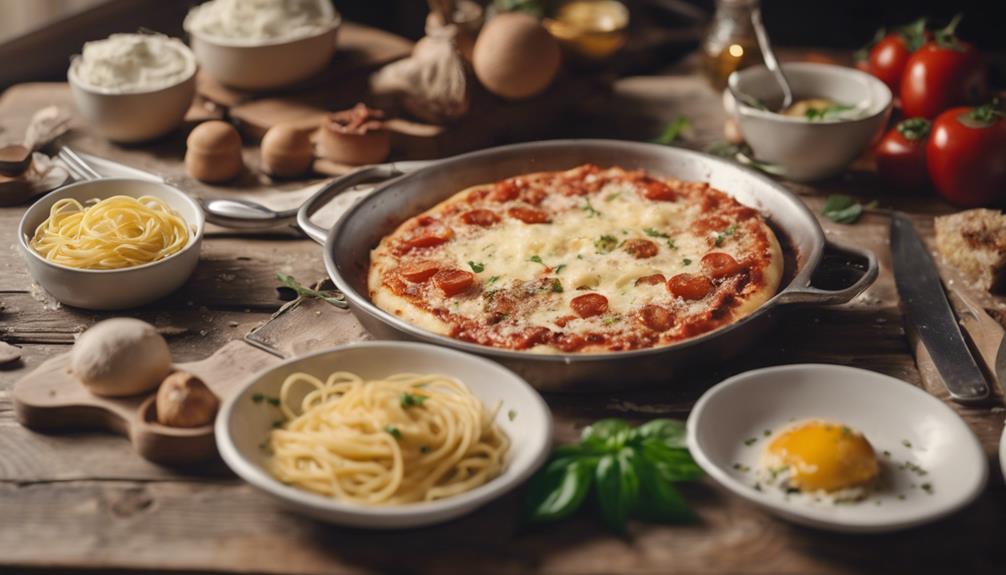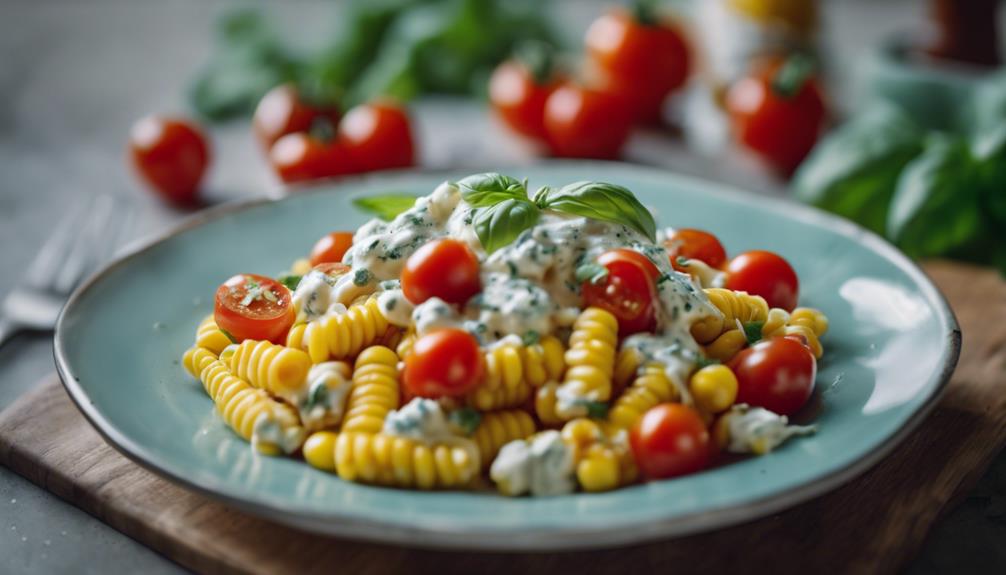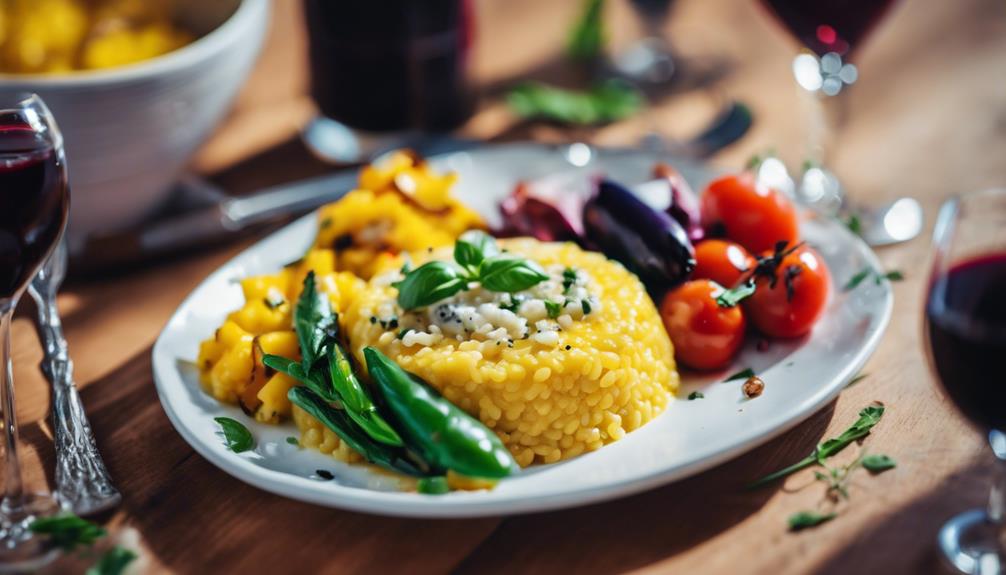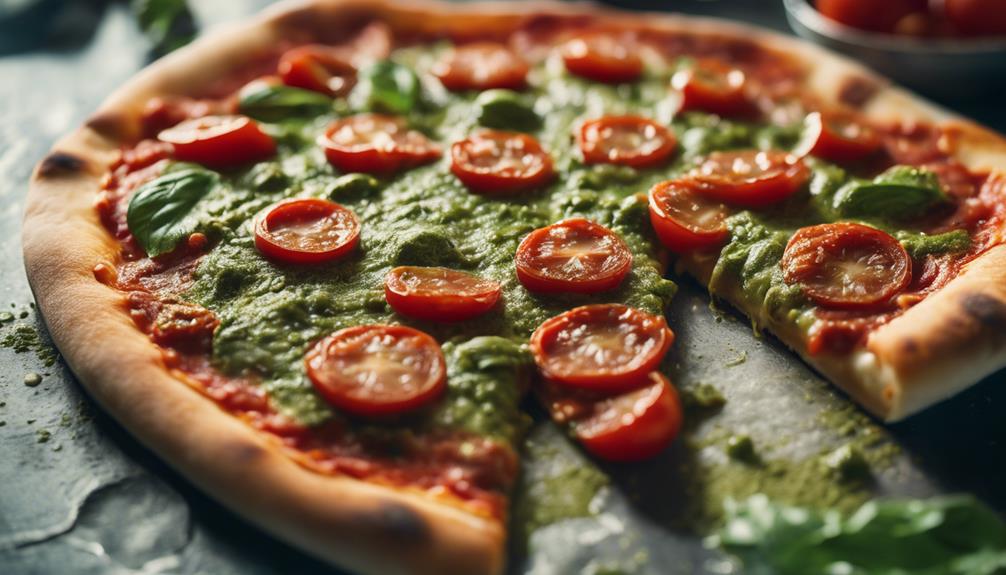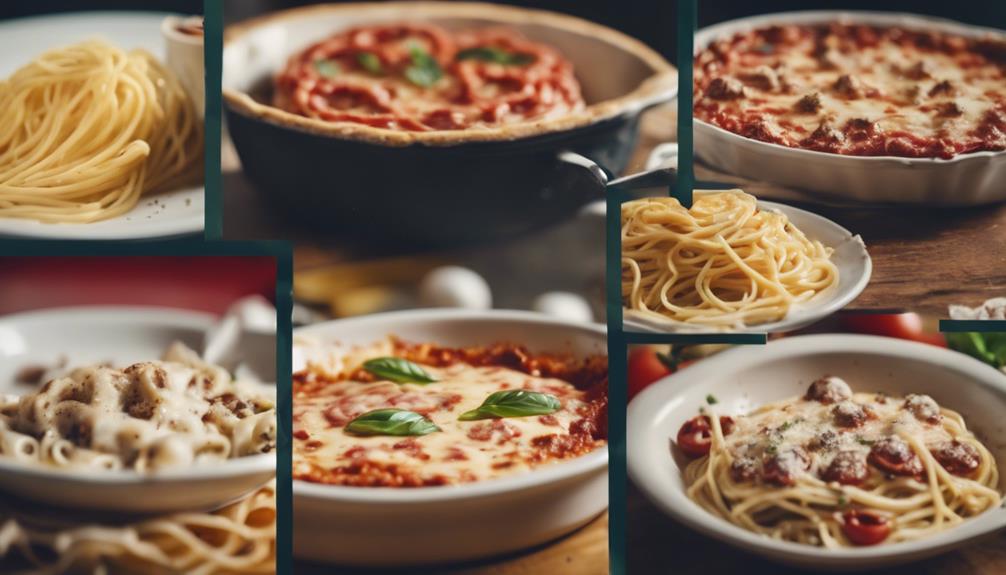Embark on an Italian culinary adventure by starting with classics such as perfectly cooked spaghetti in a rich tomato sauce or creamy risotto alla Milanese. Indulge in hearty meat dishes like Osso Buco or Chicken Scarpariello. Treat yourself to comforting soups like Minestrone or flavorful vegetable risotto. Dive into the world of traditional pizza with options like Margherita or Quattro Stagioni. Delight in seafood specialties such as Linguine alle Vongole or seafood risotto. Make sure to leave space for decadent desserts like Tiramisu or Cannoli. From appetizers to desserts, each dish showcases Italy’s vibrant food culture. There’s a whole universe of flavors waiting for you!
Key Takeaways
- Classic Italian pasta dishes like Spaghetti alla Carbonara and Bucatini All'Amatriciana are iconic favorites.
- Hearty meat entrees such as Osso Buco and Braciole showcase rich culinary heritage.
- Comforting soups like Minestrone and Tortellini Soup offer warmth and flavor.
- Indulgent desserts like Tiramisu and Cannoli are must-try Italian treats.
- Antipasti starters like Bruschetta and Caprese Salad celebrate fresh ingredients and traditional flavors.
Classic Italian Pasta Dishes
Indulge in the savory delights of classic Italian pasta dishes, featuring a medley of traditional flavors and ingredients. When it comes to Italian cuisine, few things are as comforting and satisfying as a classic Italian pasta dish.
Picture a plate of al dente spaghetti coated in a rich tomato sauce, sprinkled with freshly grated Parmesan cheese – a simple yet flavorful delight that embodies the essence of Italian cooking.
In Italy, pasta isn't just a meal; it's a way of life. Each dish tells a story of tradition and love for good food. From the creamy goodness of Spaghetti alla Carbonara to the tangy kick of Bucatini All'Amatriciana, these dishes are a celebration of fresh ingredients and time-honored recipes.
The secret lies in the simplicity – letting the flavors of quality ingredients like pancetta, fresh herbs, and Parmesan shine through.
Hearty Italian Meat Entrees

Love a good hearty meal? Get ready to tantalize your taste buds with classic Italian meat dishes that pack a flavorful punch!
From the rich and tender Osso Buco to the savory Braciole, Italian cuisine showcases a delicious array of regional meat specialties.
Don't miss out on popular favorites like Pork Chop Milanese and Chicken Scarpariello, highlighting Italy's culinary creativity at its finest.
Classic Italian Meat Dishes
Classic Italian meat dishes, such as Chicken Scarpariello, Florentine Butter Chicken, Braciole, Pork Chop Milanese, and Stracotto di Fassona Piemontese, embody the rich culinary heritage of Italy with their traditional flavors and cooking techniques. These hearty Italian meat entrees showcase the diverse regional influences of Italy, offering a mouthwatering experience for any meat lover.
- Regional Flavors:
From the tangy Chicken Scarpariello to the indulgent Pork Chop Milanese, each dish reflects the unique tastes of different Italian regions.
- Cooking Techniques:
Whether it's the slow braising of Braciole or the crispy frying of Pork Chop Milanese, Italian meat dishes are crafted with precision and care.
- Satisfaction Guaranteed:
With tender cuts of meat, flavorful sauces, and a blend of herbs and spices, these classic dishes promise a satisfying and comforting dining experience.
Indulge in these timeless Italian meat dishes that have stood the test of time, offering a savory journey through the heart of Italian cuisine.
Regional Meat Specialties
Explore the diverse culinary traditions of different Italian regions through the hearty Italian meat entrees known as Regional Meat Specialties. These Italian meat specialties offer a delightful array of flavors and textures that reflect the unique characteristics of each region.
From the classic Braciole, a thinly sliced beef dish filled with a savory stuffing, to the flavorful Chicken Scarpariello cooked with peppers and sausage, there's something to satisfy every palate.
Indulge in the comforting Tuscan-style Spareribs with a rich balsamic glaze or savor the crispy goodness of Pork Chop Milanese. For a taste of Northern Italy, try the Piedmont Braised Beef, known as Stracotto di Fassona Piemontese, which promises tender and succulent meat. And don't miss out on the Florentine Butter Chicken, a dish that combines creamy flavors with a hint of Italian herbs.
These regional meat specialties not only showcase the rich culinary heritage of Italy but also offer a delightful gastronomic experience that's sure to leave you craving for more.
Popular Meat Entrees
Delight your taste buds with a variety of hearty Italian meat entrees that showcase the rich flavors and traditional cooking techniques of Italian cuisine.
When it comes to popular meat dishes in Italy, you can't go wrong with these flavorful options:
- Chicken Scarpariello: This dish features tender chicken cooked with sausage, peppers, and onions in a delicious white wine sauce, highlighting the perfect balance of savory and invigorating flavors.
- Pork Chop Milanese: A classic favorite, this breaded and fried pork chop is served with a squeeze of lemon, adding a revitalizing citrusy kick to the crispy exterior and juicy meat inside.
- Braised Beef Braciole: Thinly sliced beef rolled up with a savory stuffing of breadcrumbs, cheese, and herbs, then braised to perfection in a rich tomato sauce, creating a melt-in-your-mouth experience that's pure comfort food.
Italian meat entrees often use traditional techniques like braising and grilling to bring out the best flavors in pork, chicken, and beef, making each dish a culinary masterpiece worth savoring.
Comforting Italian Soups
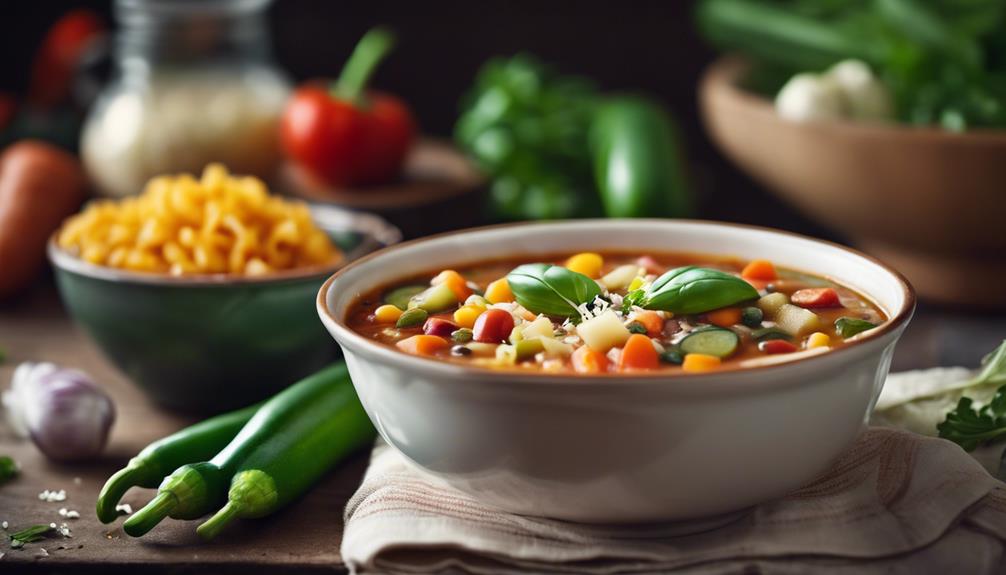
Italian soups, often hearty and comforting, are a staple in Italian cuisine, showcasing a rich blend of seasonal vegetables and beans for a satisfying flavor experience.
The classic Minestrone soup stands out with its medley of colorful vegetables, beans, and pasta, creating a wholesome and filling dish that warms you from the inside out.
For a creamier indulgence, the Creamy Tortellini Soup with Sausage offers a luxurious twist with its velvety broth, cheese-filled tortellini, and savory sausage, making it a favorite for those seeking comfort in a bowl.
If you crave a zesty kick, the Lemon Chicken Orzo Soup hits the spot with its bright lemony notes, tender chicken pieces, and delicate orzo pasta, combining flavors that dance on your palate.
These Italian soups aren't just meals; they're hugs in a bowl, perfect for chilly evenings or when you need a pick-me-up. Each spoonful tells a story of Italy's culinary heritage, emphasizing the importance of fresh, quality ingredients in creating soul-soothing recipes.
Delicious Italian Risotto Varieties
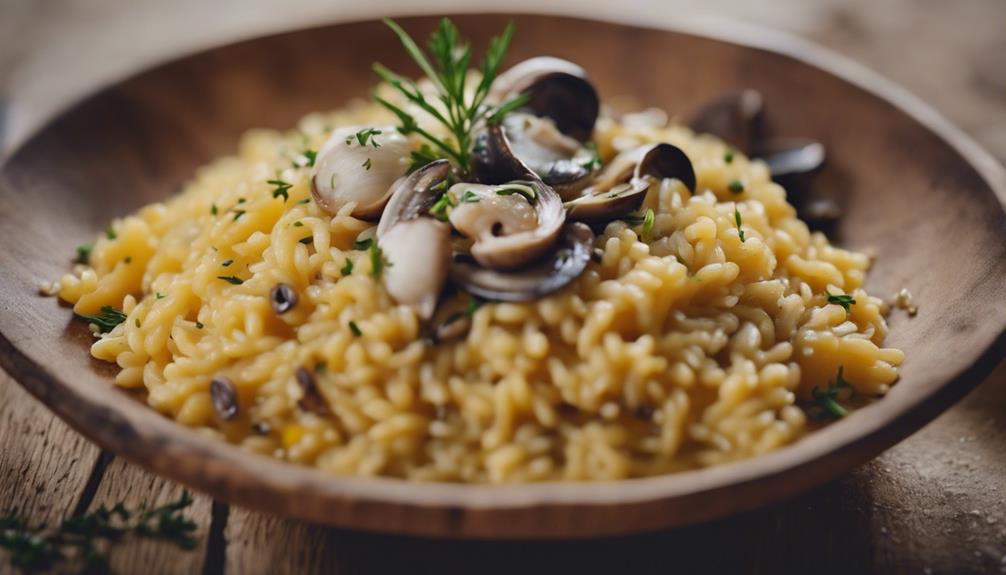
Let's now shift our focus to the delectable world of Italian risotto varieties, where creamy Arborio rice dishes shine with vibrant flavors and diverse ingredients.
When it comes to Italian Risotto, there are several mouthwatering options you must try:
- Risotto alla Milanese: This classic dish from Milan is infused with saffron, giving it a rich flavor and a striking yellow hue that's as delightful to the taste buds as it is to the eyes.
- Risotto ai Funghi: For mushroom lovers, this risotto variety is a must-try. Featuring earthy mushrooms like porcini or chanterelles, it adds a savory depth to every creamy bite.
- Risotto al Frutti di Mare: If you're a fan of seafood, this seafood-infused risotto is a decadent choice. With shrimp, clams, and mussels, it offers a burst of flavors from the sea in every spoonful.
Traditional Italian Pizza Options

Traditional Italian pizza options showcase a variety of flavors and toppings that have become iconic globally. Originating from Naples, Italian pizza is a culinary masterpiece known for its thin, crispy crust topped with tomato sauce, mozzarella, basil, and olive oil. The secret to achieving the authentic Italian taste lies in baking the pizza in wood-fired ovens, imparting that perfect charred flavor and texture.
When it comes to traditional Italian pizza varieties, classics like Margherita, Quattro Stagioni, and Capricciosa steal the show. The Margherita, with its simple yet flavorful combination of tomato, mozzarella, and basil, pays homage to Queen Margherita of Savoy. Quattro Stagioni offers a delightful medley of ingredients representing the four seasons, while Capricciosa tantalizes taste buds with artichokes, ham, mushrooms, and olives.
Neapolitan pizza, a cornerstone of Italian cuisine, reflects the culinary heritage of Italy passed down through generations.
Authentic Italian Seafood Specialties
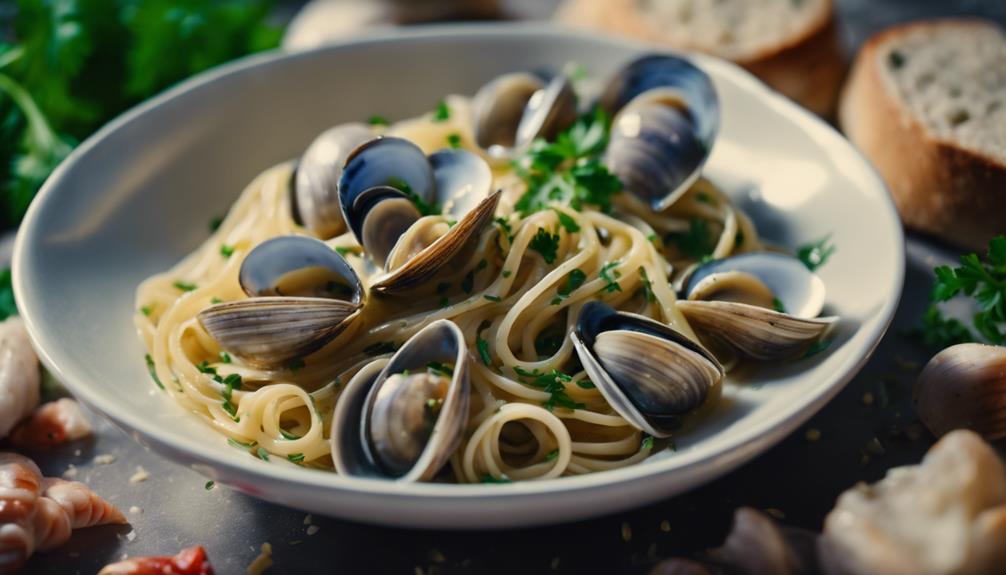
Explore the tantalizing world of Authentic Italian Seafood Specialties, where the bounties of the sea are transformed into vibrant and delicious dishes that celebrate Italy's coastal culinary traditions.
When delving into the domain of Italian seafood, you can savor dishes like:
- Seafood Risotto: A creamy and flavorful rice dish infused with an assortment of fresh seafood, herbs, and a touch of white wine, creating a harmonious symphony of flavors.
- Grilled Calamari: Tender calamari marinated in herbs and olive oil, then grilled to perfection, offering a delightful combination of smokiness and tenderness.
- Linguine alle Vongole: This classic pasta dish combines al dente linguine with clams, garlic, white wine, and parsley for a simple yet elegant taste of the sea.
Italian seafood specialties are a demonstration of the coastal influences on the country's cuisine, with offerings like seafood fettuccine, fish stew, and grilled shrimp showcasing the freshness and diversity of the Mediterranean's treasures.
Immerse yourself in these dishes for a culinary journey along Italy's picturesque shores.
Satisfying Italian Vegetarian Dishes
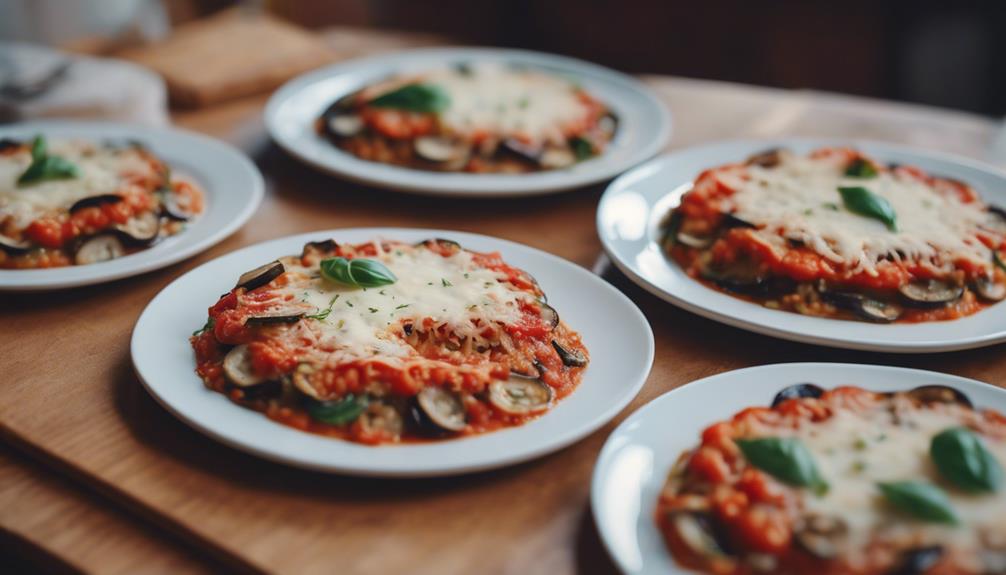
Looking for some mouthwatering vegetarian options in Italian cuisine?
How about savoring flavorful meatless pasta, indulging in delicious vegetarian pizza, or enjoying a traditional veggie risotto?
These dishes pack a punch of vibrant flavors and are sure to satisfy your cravings for a hearty and satisfying meal!
Flavorful Meatless Pasta
Immerse yourself in the world of Italian vegetarian cuisine and discover the flavorful meatless pasta options that can enhance your dining experience.
Vegetarian Italian cuisine presents a delightful variety of pasta dishes that are both hearty and packed with flavor. Indulge in creamy tomato pasta, where the richness of the tomatoes harmonizes perfectly with the creaminess of the sauce, resulting in a satisfying dish without the need for meat.
Crispy on the outside and tender on the inside, eggplant parmesan is a timeless favorite that blends the earthy flavors of eggplant with the savory hints of melted cheese and tomato sauce.
And let's not overlook tagliatelle pasta, a comforting dish that highlights the simplicity and sophistication of Italian culinary traditions.
These meatless pasta choices not only cater to vegetarians but also offer a delicious option for anyone interested in exploring the delectable realm of Italian cuisine without meat.
Delicious Vegetarian Pizza
What makes vegetarian pizza a satisfying choice among Italian vegetarian dishes?
Vegetarian pizza, a classic Italian favorite, is a delightful medley of fresh vegetables, aromatic herbs, and a blend of cheeses, all nestled on a crispy crust.
The vibrant colors of bell peppers, earthy mushrooms, zesty onions, briny olives, tender artichokes, and fragrant basil come together to create a visually appealing and flavorful dish.
This versatile Italian creation allows for endless customization, catering to individual tastes and preferences.
Whether you prefer a thin and crispy base or a thick and chewy crust, vegetarian pizza offers a delightful experience for your taste buds.
The combination of ingredients not only highlights the essence of Italian cuisine but also provides a nutritious and delicious option for vegetarians and pizza enthusiasts alike.
Traditional Veggie Risotto
Traditional Veggie Risotto, a creamy Italian favorite, combines Arborio rice, flavorful vegetable broth, and an array of fresh vegetables like peas, mushrooms, and bell peppers to create a rich and satisfying dish.
When preparing this delectable dish, consider the following:
- Creamy Goodness: The creamy texture of veggie risotto is achieved by slowly adding warm vegetable broth to Arborio rice, allowing it to cook to perfection while absorbing the flavors of the broth and vegetables.
- Key Ingredients: Enhance the flavors of your veggie risotto by using high-quality Parmesan cheese, butter, and a splash of white wine to elevate the taste profile and create a harmonious blend of ingredients.
- Variety of Options: Explore different variations of veggie risotto such as Risotto ai Funghi, Risotto Primavera, or Risotto ai Peperoni to experience a range of flavors and textures that celebrate the essence of Italian cuisine.
With its versatility and comforting appeal, traditional Veggie Risotto stands as a delightful vegetarian option that captures the essence of Italian flavors in every creamy bite.
Indulgent Italian Desserts

Indulge in the decadent flavors of Italian desserts like Tiramisu and Cannoli, featuring layers of espresso-soaked ladyfingers and creamy ricotta fillings. These indulgent treats are just the beginning of the delightful world of Italian sweets. From the velvety textures of Gelato to the sweet-tart combination in a Cherry and Dark Chocolate Crostata, Italian desserts offer a wide range of flavors to satisfy your sweet tooth.
To give you a taste of the variety, here's a table showcasing some popular Italian desserts:
| Dessert | Description | Main Ingredients |
|---|---|---|
| Tiramisu | Layers of espresso-soaked ladyfingers and creamy ricotta filling | Espresso, Ricotta |
| Cannoli | Crisp pastry shells filled with creamy ricotta | Ricotta |
| Gelato | Italian ice cream known for its velvety texture and intense flavors | Fresh Ingredients |
| Crostata | Open-faced fruit tart highlighting the sweetness of Piedmont cherries | Cherries, Dark Chocolate |
These desserts are the perfect way to end a delicious Italian meal. Buon appetito!
Italian Antipasti and Starters

Italian Antipasti and Starters offer a delightful array of cured meats, cheeses, olives, and marinated vegetables to tantalize your taste buds before the main course. Here are some must-try options:
- Bruschetta: Sliced toasted bread topped with a flavorful mix of tomatoes, garlic, basil, and olive oil. It's a classic choice that bursts with invigorating flavors.
- Caprese Salad: A simple yet elegant dish featuring slices of ripe tomatoes, fresh mozzarella cheese, basil leaves, olive oil, and a sprinkle of salt. It's a revitalizing and light starter.
- Arancini: These are fried rice balls filled with gooey cheese, savory ragu, and peas. Each bite offers a delightful combination of textures and flavors.
Italian antipasti aren't just appetizers; they're a celebration of Italy's culinary heritage and a prelude to a memorable dining experience. These starters set the stage for the feast to come, showcasing the essence of Italian cuisine through their quality ingredients and traditional recipes.
Frequently Asked Questions
What Are the Top 10 Italian Dishes?
You'll find a delightful array of Italian dishes to savor. From pasta classics like Spaghetti alla Carbonara to rich desserts like Tiramisu, the flavors of Italy will transport you to culinary bliss.
What Is Italy's Most Popular Dishes?
Italy's most popular dishes include pizza Margherita, pasta Carbonara, lasagna, risotto, gelato, tiramisu, and cannoli. Try them for a taste of Italy's rich culinary tradition, blending flavors and textures in dishes loved worldwide for their deliciousness.
What Are 5 Traditional Italian Dishes?
When exploring traditional Italian dishes, you'll find pasta alla carbonara, risotto alla Milanese, ossobuco, pizza Margherita, and tiramisu. Each dish represents Italy's culinary diversity, offering a taste of its rich heritage.
What Should I Serve for an Italian Dinner?
For an Italian dinner, serve classic dishes like Spaghetti alla Carbonara, Lasagna, Chicken Parmesan, and Risotto alla Milanese. Pair with Focaccia bread or a Caprese salad. End with Tiramisu, Cannoli, or Gelato. Enjoy with Chianti or Prosecco.
Can Tomato Risotto With Burrata be Considered One of the Best Italian Dishes?
When it comes to classic Italian dishes, it’s hard to beat a creamy tomato risotto recipe. The combination of rich, savory risotto with the creamy goodness of burrata cheese creates a dish that’s both comforting and luxurious. With the perfect balance of flavors and textures, it’s no wonder this dish is considered one of the best in Italian cuisine.
Conclusion
So there you have it, a taste of the best Italian dishes to satisfy your cravings. From classic pasta dishes to indulgent desserts, there's something for everyone to enjoy.
So next time you're looking for a delicious meal, why not try one of these authentic Italian specialties? You won't be disappointed – trust me, your taste buds will thank you!
Buon appetito!
